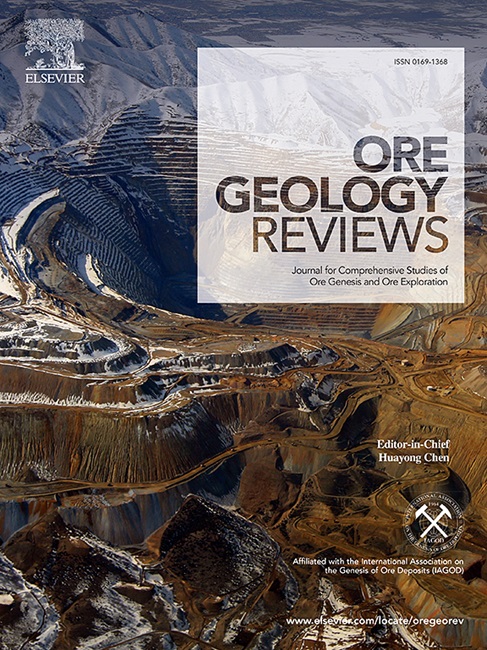Protracted hydrothermal alteration of the Burgundy alkalic porphyry prospect determined by in situ U-Pb and Rb-Sr petrochronology, northwestern British Columbia, Canada
IF 3.2
2区 地球科学
Q1 GEOLOGY
引用次数: 0
Abstract
The Late Triassic Burgundy porphyry system in the Golden Triangle of northwest British Columbia, Canada hosts Cu-Au mineralization in multiple prospective centers. Preliminary geologic mapping of the surface expression of the prospect and a cross section through the southern extension at The Ridge provide a preliminary structural understanding of the system with respect to the surrounding host rocks. The porphyries that make up the Burgundy prospect are emplaced into Upper Stikine Assemblage to Lower Stuhini Group strata with discrete episodes of texturally and geochemically distinct porphyry emplacement and igneous/hydrothermal brecciation. Lithogeochemical data indicate the prospect is a silica-undersaturated alkalic porphyry system consistent with the ubiquitous absence of quartz. A complex history of potassic, calc-potassic, phyllic, and propylitic alteration events overprint the porphyries, breccias, and wallrocks. The age of alteration was determined using in situ U-Pb and Rb-Sr geochronology. Titanite U-Pb (212.8 [±2.6] to 208.6 [±1.9] Ma), apatite U-Pb (216.7 [±2.9] to 208.2 [±4.1] Ma), garnet U-Pb (215.1 [±1.3] to 211.4 [±0.95] Ma), and biotite Rb-Sr (218.9 [±5.4] to 200.5 [±0.5] Ma) ages are interpreted alongside trace and major element geochemistry to reflect the timing of hydrothermal precipitation and/or equilibration of the dated phases during infiltration of hydrothermal fluids.
The geochronology results define a minimum emplacement age for the porphyry suite and outline a protracted period (>10 Myr) of localized, likely episodic, post-emplacement hydrothermal alteration/equilibration. The oldest ages from apatite (216.7 ± 2.9 Ma), garnet (215.1 ± 1.3 Ma), and biotite (218.9 ± 5.4 Ma) indicate emplacement of Burgundy porphyries began before emplacement of the neighboring Galore Creek alkalic suite (212–205 Ma). In addition, the youngest biotite date (200.5 ± 0.5 Ma) indicates Burgundy experienced localized high-T hydrothermal fluid infiltration associated with either a long-lived hydrothermal system related to cooling of structurally deeper Burgundy melts and/or externally derived fluids during the onset of local Tatogga/Texas Creek suite magmatism. The new age data from Burgundy indicate alkalic magmatism in the Golden Triangle began earlier than is currently recognized within the working regional framework model and that Burgundy was a conduit for protracted hydrothermal activity during this critical metallogenic epoch near the Triassic-Jurassic boundary.

求助全文
约1分钟内获得全文
求助全文
来源期刊

Ore Geology Reviews
地学-地质学
CiteScore
6.50
自引率
27.30%
发文量
546
审稿时长
22.9 weeks
期刊介绍:
Ore Geology Reviews aims to familiarize all earth scientists with recent advances in a number of interconnected disciplines related to the study of, and search for, ore deposits. The reviews range from brief to longer contributions, but the journal preferentially publishes manuscripts that fill the niche between the commonly shorter journal articles and the comprehensive book coverages, and thus has a special appeal to many authors and readers.
 求助内容:
求助内容: 应助结果提醒方式:
应助结果提醒方式:


